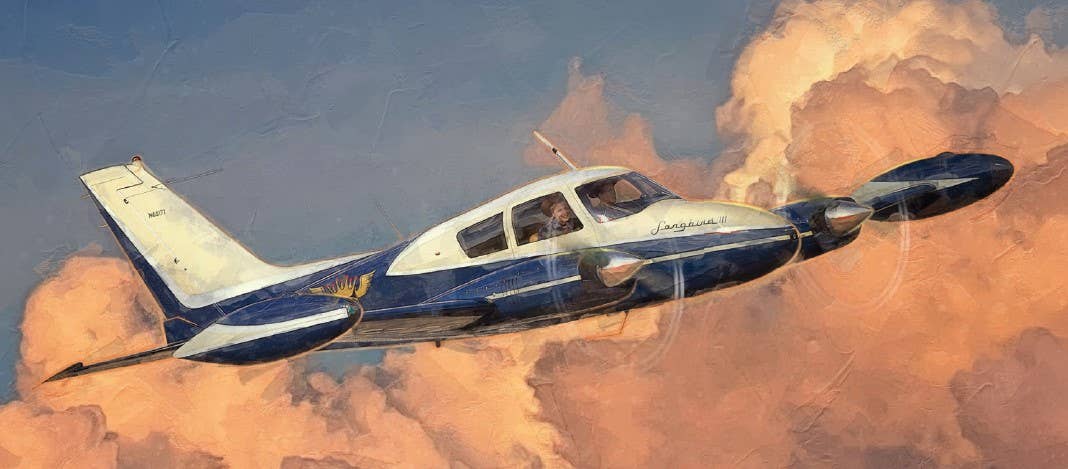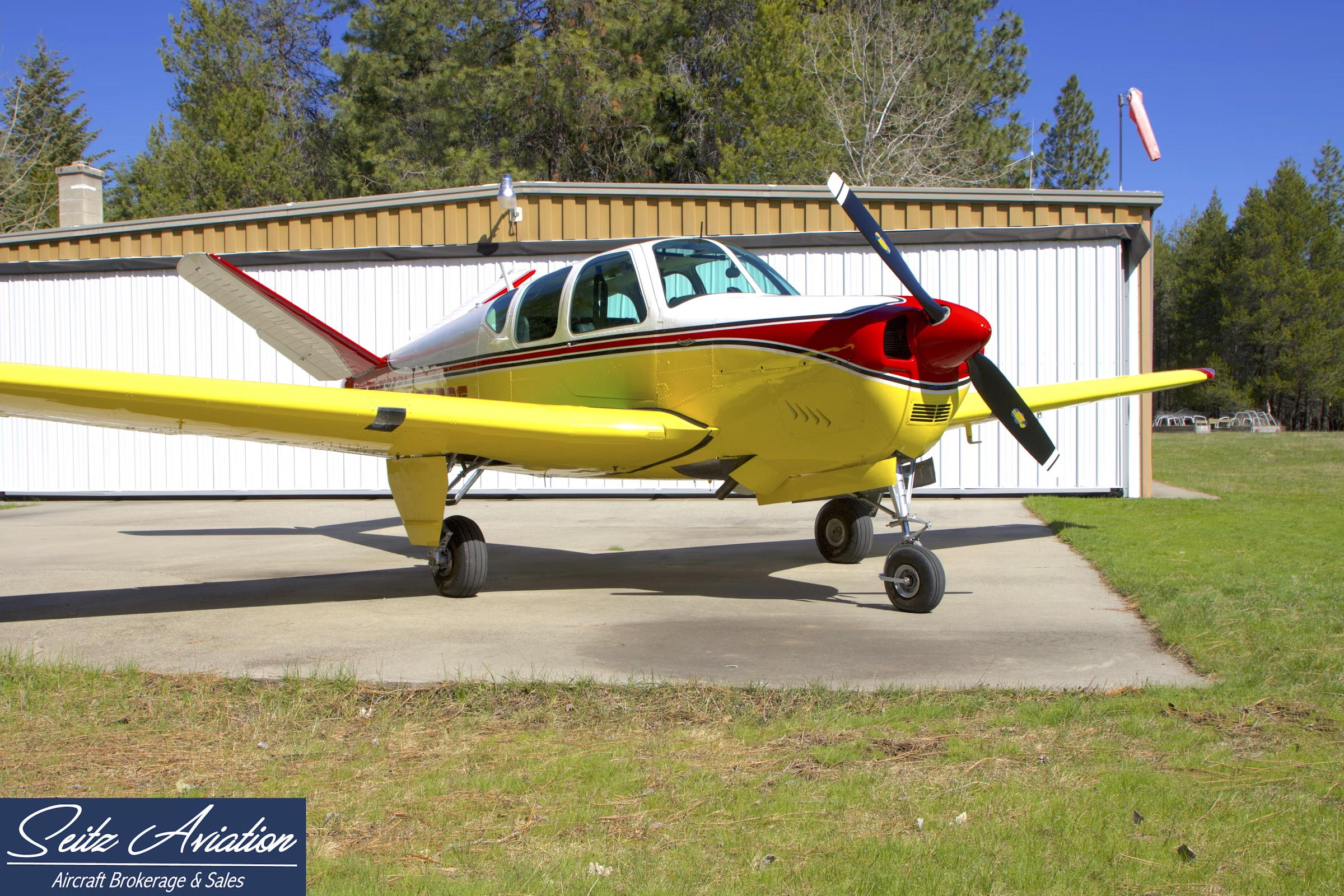Ultimate Issue: When TV Stars Had Wings
Memories of those little airplanes that made the small screen come alive.

The first and arguably most successful aviation-themed TV show was the weekly series ‘Sky King.’ [Courtesy: Ron Finger/Redpine Studio]
With the emergence of reality TV, most pilots will admit to having binge watched some sort of program about flying, usually based in the cold northern regions and always involving perilous situations and larger-than-life characters.
Ice Pilots, Flying Wild Alaska, and Airplane Repo immediately come to mind, and each has featured general aviation airplanes in a starring role. However, turn the clock back a few years and TV and movie star pilots were nothing new in the post-World War II American landscape. Academy Award winner Jimmy Stewart was a decorated WWII bomber pilot and starred in a series of aviation-themed movies after the war, most notably 1957’s Spirit of St. Louis.
Meanwhile, on the small screen, the Golden Age of Television was in full swing. Arthur Godfrey, a star of both radio and TV and an accomplished pilot, regularly featured his flying exploits with Eastern Airlines and Captain Eddie Rickenbacker on the radio and later television. And, of course, who can forget Milton Caniff’s comic strip “Steve Canyon,” the mythical lieutenant colonel who seemingly flew every aircraft in the Air Force inventory, brought right into your living room by the magic of TV.
Along with these military-themed shows, over the next few decades several weekly television series leveraged the allure of the small single- and twin-engine planes of the time to create drama, comedy, and hopefully strong ratings. As we will see, some did, and some did not.
‘Out of a Clear Blue of the Western Sky Comes…SKY KING!’
The first and arguably most successful of these aviation-themed adventures was the weekly series Sky King.
This adaptation of a 15-minute radio serial featured the adventures of Arizona rancher Schuyler King, a former naval aviator-turned-rancher, and his air racer niece Penny. But the real star of this children’s show was their trusty Cessna Twin, the Songbird, that flew into your living room each week from the Flying Crown Ranch.
When most people think of the Songbird, they see the beautiful 1957 Cessna 310B, N5348A. However, this particular airplane was only one of several aircraft used in the filming of the series from its inception in 1951 to its final episode in 1959.
So, let’s talk about the two Cessnas that proudly carried the Songbird legacy and a few of the extras found hanging around the set.
The Original Songbird, the Cessna T-50 Bobcat
In fact, the Songbird twin that appeared in the first 39 episodes of Sky King was a Cessna T-50 Bobcat, owned and operated by aviation film legend Paul Mantz.
The T-50, or “Bamboo Bomber” as it was often called, was produced from 1939-44. To conserve strategic materials for the war effort, the T-50 was constructed of wood, fabric, and steel tubes, hence the nickname. More than 5,000 were built for service with the Army Air Corps and the Royal Canadian Air Force. Bobcats trained pilots, navigators, and bombardiers, as well as performing liaison and passenger-carrying duties. The military designation for this versatile aircraft was the AT-17 or UC-78. The particular aircraft used in the series was originally an Army Air Corps UC-78 purchased as surplus and registered under a civilian type certificate as a T-50, N67832.
The little Bobcat was the perfect aircraft type to operate out of Sky King’s Flying Crown Ranch. From there, it would land on some backcountry strip or country road to catch the bad guys or rescue Penny from the clutches of some new villain. Its taildragger configuration featured partially retractable landing gear, a sturdy spruce spar, fixed tailwheel, and a roomy cabin with large windows. The big windows made filming those close-up shots of Sky and Penny much easier. Power was supplied by two 245 hp Jacobs 7-cylinder radials. Sky could count on a cruise speed of around 170 mph, a stall speed of around 65 mph, and for those backcountry emergency takeoffs, a takeoff run of 650 feet.
Of course, Sky (played by Kirby Grant) and Penny (portrayed as his teenage niece for nine years by Gloria Winters) did not actually fly the Songbird. That chore fell to Mantz and the professional Hollywood pilots he employed. This original Songbird was featured in the first 39 episodes, filmed between ’51 and ’56, and soldiered on in the role until it began to show its age. By then, Cessna had a new twin-engine plane on the horizon it wanted to promote.
Songbird No. 2, the Cessna 310B
The Songbird that many of us remember from our childhood was the elegant Cessna 310. However, this was not just any 310.
Cessna, eager to promote its new twin, loaned the second production Cessna 310B, N5348A, to the production company and provided a company pilot to fly it. This original version of the 310 was unique in many respects. It featured the straight vertical tail common to Cessna singles at the time, two Continental O-470-M engines with large extractor tube exhausts, and two large 51-gallon tip tanks in which all the aircraft fuel was carried.
The theory at the time was that keeping the fuel as far away from the occupants as possible was a good thing. The new 310B cruised at a bit over 200 mph, could range out nearly 900 nm from the Flying Crown, and in its distinctive Songbird paint livery looked the part. This particular 310B was featured in the final 32 episodes of Sky King from 1956-59. Of course, both Songbirds lived on in endless Saturday morning reruns for the next 30 years, many which can still be found on YouTube.
And the Rest of the Songbirds
First, a word about Hollywood TV production. The Flying Crown Ranch, located in the mythical town of Grover, Arizona, was actually a film location in Apple Valley, California. And the two Songbirds were not the only ones required for filming. Two additional T-50 Bobcats, plentiful in postwar 1950s America, were used for additional scenes inside the cockpit and on the ground.
Once the 310 became the star of the show, Cessna provided a 310 fuselage section, with the windows removed, for interior filming. When the original Cessna 310 was destroyed in an accident in 1962, a Cessna 310D became the public appearance stand-in for the series, which was still in syndication. If you watch the series, you can see each of these Songbirds at work.
The good news is that the final Cessna 310D used for publicity photos and personal appearances, a Cessna 310D named Songbird III, is still flying and appears regularly at EAA AirVenture in July at Oshkosh, Wisconsin, and airshows around the country. No worries that Songbird III has a swept tail and an upgraded paint scheme. It keeps the spirit of Sky and Penny alive for a new generation.
The New Bob Cummings Show
Just as Sky King was wrapping up production, another of Hollywood’s most accomplished pilots, Robert Cummings, combined his vocation, acting, and his avocation, flying, in a TV series. The New Bob Cummings Show featured Cummings’ personal airplanes, including the revolutionary Aerocar I, considered one of the world’s first practical flying cars.
Charles Clarence Robert Orville Cummings was born in Joplin, Missouri, in 1910. Cummingssoloed an airplane in 1927 and was active in the Civil Air Patrol during WWII.
Legend has it that when CFIs were officially licensed, Cummings held flight instructor certificate No. 1. In the 1950s, with his movie career beginning to fade a bit, Cummings shortened his name to Bob and began a successful career on television. His most successful series, aptly titled The Bob Cummings Show, was on the air from 1954-59 to good reviews.
Returning to the small screen in 1961, his next series, The New Bob Cummings Show, combined his love of aviation with the light comedy roles that had made him famous.
The Aerocar
The star of the show was none other than Moulton “Molt” Taylor’s unique Aerocar.
The premise for the series was that Cummings portrayed a professional charter pilot who flew the Aerocar in and out of a series of personal adventures. The Aerocar in question, N102D, was the last Aerocar I of the four manufactured and was Cummings’ personal airplane.
In addition to the four Aerocar I models, an additional Aerocar II and Aerocar III (modified from an Aerocar I) brought the total production to five, or six, depending on how you count. Aerocar N102D is in private hands today and is reputed to be the only one maintained in flying condition. It was most recently on public display at the Kissimmee Air Museum in Florida, until it closed its doors in 2021. However, each of the Aerocars survived, and most are on display at various aviation museums around the country.
Cummings’ Aerocar I was the only example to feature the more powerful Lycoming O-360, the remainder featuring the O-320, which gave it a little better performance. The transition from airplane to car, and vice versa, is an orderly yet complex one. In the air, the Aerocar features a strutted monoplane wing and pusher propeller driven by a long driveshaft. The Aerocar climbs at 600 feet per minute, cruises at nearly 90 mph, and has a theoretical 12,000-feet service ceiling.
On the road, the 4-cylinder-opposed Lycoming is mated to a three-speed transmission and can propel the little two-seater to 60 mph. However, the noise, vibration, and harshness (NVH) left much to be desired, both then and now.
The Aerocar featured a compact two-seat cabin and motorcycle fenders. Once on the ground, the wings would fold back against the tail boom, and the propeller shaft disconnected from the rear of the car, the socket being covered by the license plate.
With the wings and tail converted into a roadable trailer, the pilot turned driver could either leave them parked at the airport or trailer them along with the car to the next destination—a handy feature if the ceiling and visibility closed in unexpectedly. Advertising materials of the time boasted a transition from car to airplane of five minutes. While the transition process is simple, a little more time spent in the transition might provide more peace of mind.
Sadly, The New Bob Cummings Show lasted only one season and was canceled in 1962. However, the star of the show was the world’s only certified flying car. Taylor Aerocar advertisements of the period proudly proclaimed, “featured on The New Bob Cummings Show.”
Wings
Arguably one of the most successful aviation-themed TV series, Wings enjoyed a successful eight-season run from 1990-97.
The comedy featured actors Tim Daly, Steven Webber, and Crystal Bernard, and was based on a fictional airline, Sandpiper Air, based at the equally fictional Tom Nevers Field on Massachusetts’ Nantucket Island.
The airline’s single aircraft was a venerable 1981 Cessna 402C, N121PB. Sandpiper Air was loosely based on a series of charter and scheduled airlines using this general aviation workhorse, the most recognizable of which may be Provincetown-Boston Airlines (PBA) and Cape Air.
The 402 series was designed as an unpressurized, reliable, and relatively inexpensive to purchase and operate light twin. It comes in two flavors, the Utiliner is a more spartan 10-passenger people hauler, and the Businessliner sported a plusher interior more suited to private or corporate ownership. The C model sported two 235 hp Continentals and traded the tip tanks of earlier models for longer wings. More than 1,500 were built from 1966-85.
The 402 series remains an excellent step-up airplane for multiengine-rated pilots, and when operated single pilot on medium-length legs, it has become a workhorse around the world. A 10-seat cabin mock-up (with the windows removed for filming) provided a roomy setting for some of the most memorable moments of the show.
It was only fitting that the aircraft used in the flying scenes during the show was eventually sold to Cape Air and soldiered on carrying many happy passengers to Nantucket and other East Coast destinations, just the way it had on Wings.
And Then There Was The Tim Conway Show
Not all TV series featuring likable characters and a classic airplane were created equal. In fact, Wings was not the first show to feature a GA twin serving as a one-horse airline.
Twenty years before the debut of Wings, multiple Emmy Award winning comedian Tim Conway premiered on what seemed a surefire-hit show centered around two happy-go-lucky pilots making a living flying people and cargo. The Tim Conway Show was the home of Triple A Airlines and featured a single Beechcraft 18, named Lucky Linda. It paired Conway with future McHale’s Navy costar Joe Flynn.
The comedy was slapstick, and the flying scenes featured frantic takeoffs, bounced landings, and incredibly smoky engine starts thanks to the Twin Beech’s radial engines. While Conway and Flynn went on to greener pastures, blessedly The Tim Conway Show did not. It premiered in January 1970, lasted a scant 13 episodes, and was off the air by the end of June of the same year.
Flying Wild Alaska
These days, reality TV series feature daring pilots, usually flying well north of the 49th parallel, and serving as the link between civilization and the isolated villages of the north country.
One stands out for its use of an iconic general aviation aircraft. Flying Wild Alaska ran for two seasons (2011-2012) and featured the exploits of the Tweto family, especially Jim Tweto, the chief operating officer of Era Alaska, and his youngest daughter and reality TV series regular, Ariel Tweto.
The series, set in and around Unalakleet, Alaska, often featured the workhorse of the Era fleet, the Cessna 207 Skywagon, and Jim Tweto’s personal tundra tire/ski-equipped Cessna 185.
The Skywagon is pretty much a flying SUV. It seats seven and is similar in capability to the Cherokee Six. However, its high-wing configuration allows for greater clearance between snowbanks and on unprepared airstrips.
With fixed landing gear, an immense cargo door, and a stretched nose that contained an additional baggage compartment, the 207 is sort of an ultimate Cessna 172, and well suited for the rugged conditions. Powered by a 300 hp Continental, the production run spanned more than 600 examples. The Cessna 185 remains a backcountry favorite that’s able to get in and out of incredibly short landing strips and sandbars.
As a sad footnote, the aviation community lost Jim Tweto in 2023 in the crash of his beloved Cessna 185.
So, there you have it. Several TV series attempted to show the drama, excitement, and good humor that each of us has found in GA—some successfully, some not so much. From the many Songbirds, to the unique and wonderful Aerocar, and each of the others, the airplanes played a leading role. In this age of computer-generated imaging (CGI), superheroes, and rom-coms, we will just have to settle for binge watching Ice Pilots. However, if you search on YouTube for 1950s aviation TV, you may hear: “Out of a clear blue of the western sky comes…SKY KING!”
This feature first appeared in the Summer 2024 Ultimate Issue print edition.

Sign-up for newsletters & special offers!
Get the latest FLYING stories & special offers delivered directly to your inbox






